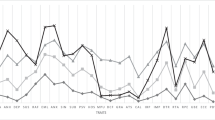Abstract
Ostensible psychiatric comorbidity can sometimes be explained by shared relations between diagnostic constructs and higher order internalizing and externalizing dimensions. However, this possibility has not been explored with regard to comorbidity between personality pathology and other clinical constructs in adolescents. In this study, personality pattern scales from the Millon Adolescent Clinical Inventory in a sample of 492 adolescent inpatients were subjected to a principal components analysis to yield oblique internalizing and externalizing dimensions. Relations between personality dimensions and well-established measures of psychopathology (depression, alcohol abuse, drug abuse) and other indicators of clinical dysfunction (self-esteem, suicidality, violence) were assessed before and after controlling for these higher-order personality dimensions. Associations between personality scales and indicators of psychopathology and clinical dysfunction were minimal with these higher order components controlled. These results suggest that internalizing and externalizing personality dimensions explain most of the associations between personality patterns and indicators of psychopathology and clinical dysfunction in adolescent patients.
Similar content being viewed by others
Notes
Very similar results were observed with a principal axis factor analysis. These results are available from the corresponding author upon request.
References
Achenbach TM (1966) The classification of children’s psychiatric symptoms: a factor analytic study. Psychol Monogr 80:37
Krueger RF (1999) The structure of common mental disorders. Arch Gen Psychiatry 56:921–926
Krueger RF, Hicks BM, Patrick CJ, Carlson SR, Iacono WG, McGue M (2002) Etiologic connections among substance dependence, antisocial behavior, and personality: modeling the externalizing spectrum. J Abnorm Psychol 111:411–424
Hopwood CJ, Baker KL, Morey LC (2008) Personality and drugs of choice. Personal Ind Diff 44:1413–1421
Markon K, Krueger RF, Watson D (2005) Delineating the structure of normal and abnormal personality: an integrative hierarchical approach. J Pers Soc Psychol 88:139–157
Watson D (2005) Rethinking the mood and anxiety disorders: a quantitative hierarchical model for DSM-V. J Abnorm Psychol 114:522–536
Widiger TA, Clark LA (2000) Toward DSM-V and the classification of psychopathology. Psychol Bull 126:946–963
Becker DF, Grilo CM, Edell WS, McGlashan TH (2000) Comorbidity of borderline personality disorder with other personality disorders in hospitalized adolescents and adults. Am J Psychiatry 157:2011–2016
McGlashan TH, Grilo CM, Skodol AE, Gunderson JG, Shea MT, Morey LC, Zanarini MC, Stout RL (2000) The collaborative longitudinal personality disorders study: baseline Axis I/II and II/II diagnostic co-occurrence. Acta Psychiatr Scand 102:256–264
Grilo CM, Walker ML, Becker DF, Edell WS, McGlashan TH (1997) Personality disorders in adolescents with major depression, substance use disorders, and co-existing depression and substance use disorders. J Consult Clin Psychol 65:328–332
Paris J (2005) The development of impulsivity and suicidality in borderline personality disorder. Dev Psychopathol 17:1091–1104
Grilo CM, McGlashan TH, Quinlan DM, Walker ML, Greenfeld D, Edell WS (1998) Frequency of personality disorders in two age cohorts of psychiatric inpatients. Am J Psychiatry 155:140–142
Donnellan MB, Conger RD, Burzette RG (2007) Personality development from late adolescence to young adulthood: differential stability, normative maturity, and evidence for the maturity-stability hypothesis. J Pers 75:237–267
Crawford TN, Cohen P, Brook JS (2001) Dramatic-erratic personality disorder symptoms: II. Continuity from early adolescence to adulthood. J Personal Disord 15:319–335
Becker DF, Grilo CM, Morey LC, Walker ML, Edell WS, McGlashan TH (1999) Applicability of personality disorder criteria to hospitalized adolescents: evaluation of internal consistency and criterion overlap. J Am Acad Child Adolesc Psychiatry 38:200–205
Millon T, Millon C, Davis RD (1993) Millon Adolescent Clinical Inventory. National Computer Systems Assessments, Minneapolis
McCann JT (1999) Assessing adolescents with the MACI. Wiley, New York
Millon T, Davis RD (1993) The Millon Adolescent Personality Inventory and the Millon Adolescent Clinical Inventory. J Couns Devel 71:570–574
Pinto M, Grilo CM (2004) Reliability, diagnostic efficiency, and validity of the Millon adolescent clinical inventory: examination of selected scales in psychiatrically hospitalized adolescents. Behav Res Ther 42:1505–1519
Romm S, Bockian N, Harvey M (1999) Factor-based protypes of the Millon Adolescent Clinical Inventory in adolescents referred for residential treatment. J Personal Assess 72:125–143
Beck AT, Steer RA (1987) Manual for the revised Beck Depression Inventory. Psychological Corporation, San Antonio
Grilo CM, Masheb RM, Wilson GT (2001) Subtyping binge eating disorder. J Consult Clin Psychol 69:1066–1072
Watson D, Clark LA (1984) Negative affectivity: the disposition to experience aversive emotional states. Psychol Bull 96:465–490
Strober M, Green J, Carlson G (1981) Utility of the Beck Depression Inventory with psychiatrically hospitalized adolescents. J Consul Clin Psychol 49:482–483
Mayer JE, Filstead WJ (1979) The Adolescent Alcohol Involvement Scale: an instrument for measuring adolescents’ use and misuse of alcohol. J Stud Alcohol 40:291–300
Moberg DP (1983) Identifying adolescents with alcohol problems: a field test of the Adolescent Alcohol Involvement Scale. J Stud Alcohol 44:701–721
Martino S, Grilo CM, Fehon DC (2000) Development of the Drug Abuse Screening Test for Adolescents (DAST-A). Addict Behav 25:57–70
Skinner HA (1982) The drug abuse screening test. Addict Behav 7:363–371
Rosenberg M (1965) Society and the adolescent self-image. Princeton University Press, Princeton
Winters NC, Myers K, Proud L (2002) Ten-year review of rating scales, III: scales assessing suicidality, cognitive style, and self-esteem. J Am Acad Child Adolesc Psychiatry 4:1150–1181
Plutchik R, van Praag HM (1989) The measurement of suicidality, aggressivity and impulsivity. Prog Neuropsychopharmacol Biol Psychiatry 13:S23–S34
Greening L, Stoppelbein L, Fite P, Dhossche D, Erath S, Brown J, Cramer R, Young L (2008) Pathways to suicidal behaviors in childhood. Suicide Life Threat Behav 38:35–45
Grosz DE, Lipschitz DS, Eldar S, Finkelstein G, Blackwood N, Gerbino-Rosen G (1994) Correlates of violence risk in hospitalized adolescents. Compr Psychiatry 35:296–300
Plutchik R, van Praag HM (1990) A self-report measure of violence risk. Compr Psychiatry 31:450–456
Hopwood CJ, Morey LC, Gunderson JG, Shea MT, McGlashan TH, Skodol AE, Grilo CM (2006) Hierarchical relationships between borderline, schizotypal, avoidant and obsessive-compulsive personality disorders. Acta Psychiatr Scand 113:430–439
Acknowledgments
Dr Grilo was supported, in part, by grant K24 DK070052 from the National Institutes of Health
Author information
Authors and Affiliations
Corresponding author
Rights and permissions
About this article
Cite this article
Hopwood, C.J., Grilo, C.M. Internalizing and Externalizing Personality Dimensions and Clinical Problems in Adolescents. Child Psychiatry Hum Dev 41, 398–408 (2010). https://doi.org/10.1007/s10578-010-0175-4
Published:
Issue Date:
DOI: https://doi.org/10.1007/s10578-010-0175-4



